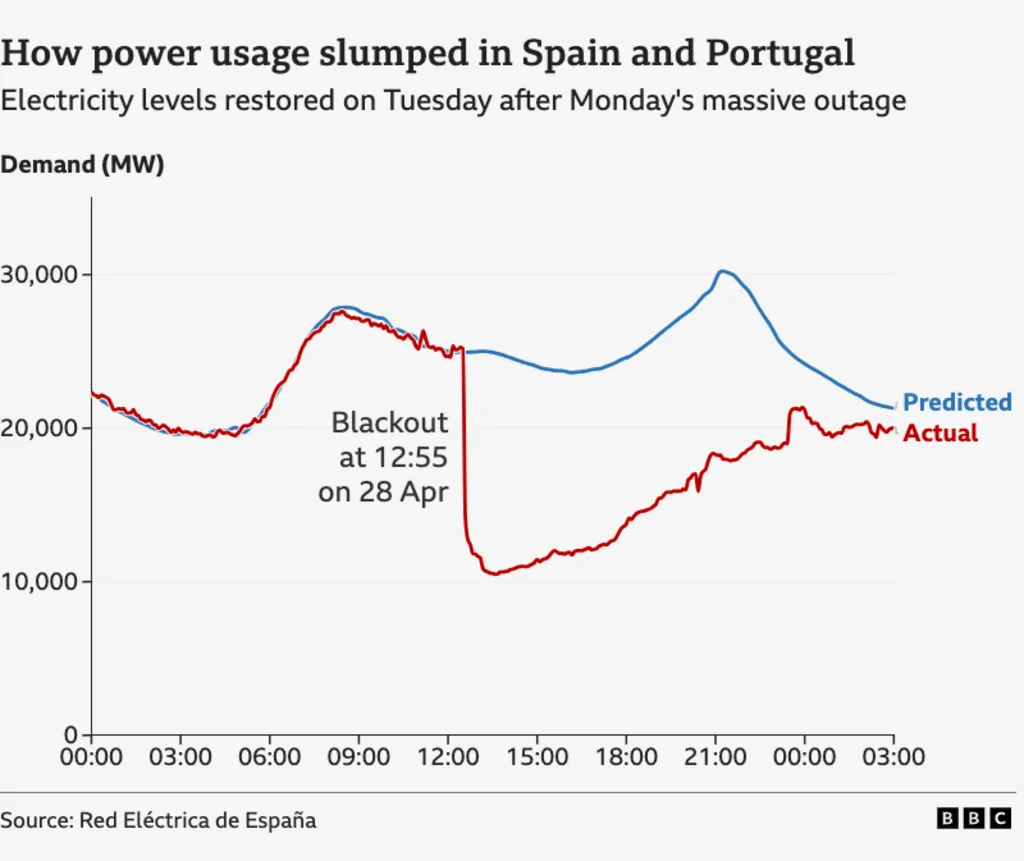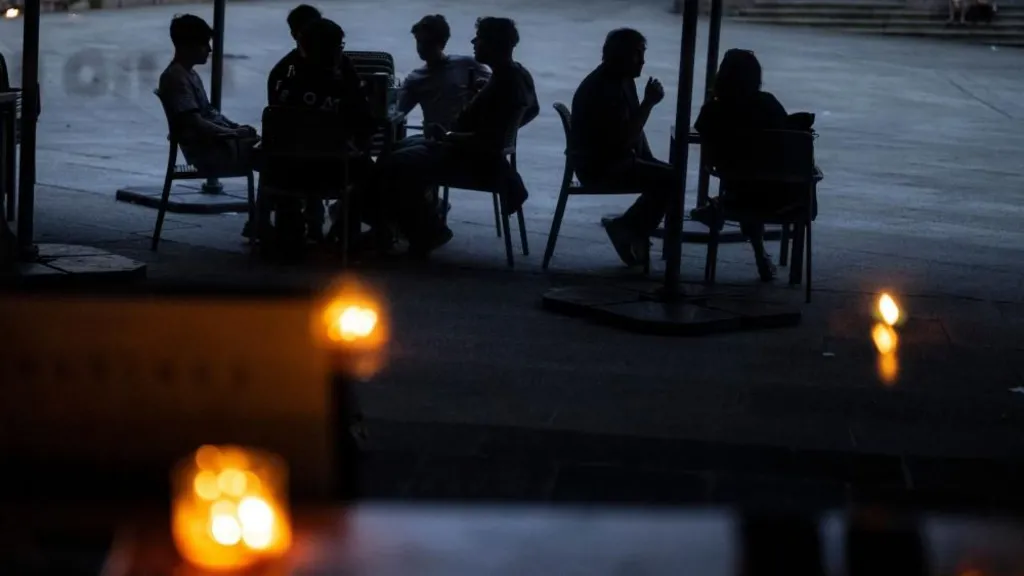As Spain and Portugal slowly return to normalcy following an unprecedented nationwide blackout, attention is shifting from the immediate chaos to the critical questions of what caused the failure—and how to prevent it from ever happening again.
The power crisis, which brought much of Spain to a standstill, lasted nearly a full day. It wasn’t until 11:15 local time (09:15 GMT) on Tuesday—almost 23 hours after the initial collapse—that Spain’s national electricity grid operator officially declared the system had stabilized and operations had returned to normal.
By then, trains had begun running again, though some rail lines remained suspended. Most homes had their electricity restored, but the memory of a darkened nation and halted infrastructure left a deep impression.
So, what went wrong—and why did it take so long to restore power?
According to early reports from grid authorities, the failure stemmed from a rare combination of events. Two separate connection issues in the country’s southwest occurred almost simultaneously, followed by a disconnection from the French power network that lasted for nearly an hour. These cascading problems triggered a massive imbalance in the system, making recovery efforts far more complex.
Prime Minister Pedro Sánchez acknowledged the severity of the situation, highlighting a stunning loss of 15 gigawatts of electricity at precisely 12:33 p.m. on Monday—roughly 60% of Spain’s total power generation capacity at that moment. The sudden drop plunged cities into darkness, stranded passengers on public transport, and disrupted communications across multiple sectors.
While emergency teams worked through the night to restore service, the event has raised significant concerns about grid vulnerability and energy security in a modern, interconnected Europe. Analysts say the crisis may lead to a re-evaluation of regional power interdependencies and faster investment in smart grid technologies and domestic resilience.
As investigations continue, the blackout stands as a stark reminder of the fragility of even the most advanced national infrastructure—and the urgent need for safeguards in an era increasingly reliant on uninterrupted energy.

Spain is recovering from a major power blackout that disrupted much of the country for nearly 23 hours. The outage, which began on Monday, caused widespread chaos—halting trains, cutting off electricity to homes and businesses, and leaving large parts of the country in darkness. Only the Canary Islands, Balearic Islands, and the enclaves of Ceuta and Melilla remained unaffected due to their separate power grids.
Red Eléctrica, the national grid operator, confirmed the system was fully restored by 11:15 a.m. on Tuesday. Eduardo Prieto, the grid’s director of operations, explained that the collapse was triggered by two nearly simultaneous disconnection events in the southwest—an area rich in solar power—followed by a temporary loss of connection to the French energy network.
At the time of the outage, Spain’s electricity mix was heavily reliant on renewables: over 60% solar, 12% wind, and 11.6% nuclear. The sudden loss of 15 gigawatts—about 60% of total power—sparked debate over whether the country’s increasing dependence on renewable energy, particularly solar, may be straining the grid’s reliability.
Critics have called for a reassessment of Spain’s energy strategy, warning that without stronger infrastructure and energy storage, future blackouts could become more likely. Prime Minister Pedro Sánchez has promised a full investigation, while energy officials face growing pressure to ensure grid stability in the face of accelerating clean energy transitions.

Despite Spain’s advanced and diversified energy mix, the national power collapse at 12:35 p.m. on Monday triggered a massive effort to restore service. The primary focus was on getting power back to Spain’s northern and southern generating regions, which grid operator Red Eléctrica described as critical for “gradually re-energising the transmission grid” as generating units were brought online.
To avoid overloading the system and triggering another widespread outage, the restoration process had to be carefully phased—a process known as a “black start.” This method proved successful, as the grid was carefully restored over time.
The initial steps involved bringing hydro-electric plants online, with pumped-storage plants—whose reservoirs were full at this time of year—playing a key role. These plants are capable of generating electricity quickly from a standing start, making them invaluable in the restoration process. Combined-cycle gas plants also contributed significantly to the recovery.
However, the nuclear sector was less helpful. Four reactors at Almaraz, Ascó, and Vandellós were automatically shut down due to the outage, and three others were already offline for maintenance. This left a notable gap in the grid’s capacity that had to be addressed by other means.
The effort to restore power underscored the delicate balance required to maintain grid stability, particularly in the face of unexpected failures. Experts and officials are now focusing on strengthening Spain’s energy infrastructure to prevent similar disruptions in the future.

Spain’s recovery from the unprecedented power outage was supported by its neighbors, France and Morocco, who came to its aid with crucial electricity transfers.
Morocco contributed by supplying 900MW of power through two high-voltage lines that cross the Strait of Gibraltar, connecting Fardioua in Morocco to Tarifa in southern Spain. This transfer played a vital role in stabilizing the grid as Spain’s domestic power generation was gradually restored.
Meanwhile, France’s power operator, RTE, also assisted by increasing electricity flow through its cross-border lines. RTE reported that the Iberian network was disconnected between 12:38 and 13:30 on Monday, during which time the 400kV line to Catalonia was down. Once restored, France began supplying 700MW to Spain, and this was later ramped up to 2,000MW to help revive the Spanish grid.
By 19:20 on Monday, Red Eléctrica, Spain’s grid operator, confirmed that more than 20% of demand had been restored through a combination of Spain’s own generation and French imports. Electricity provider Endesa had already restored power to nearly 3.5 million customers by 19:15, prioritizing hospitals and critical infrastructure.
As of 20:30, Eduardo Prieto, the head of Red Eléctrica, confirmed that about 9,200MW—roughly 35.1% of Spain’s total demand—had been restored. The recovery continued steadily, reaching 61.35% by midnight and over 99% by 07:00 on Tuesday, marking a remarkable turnaround after the major grid failure.

